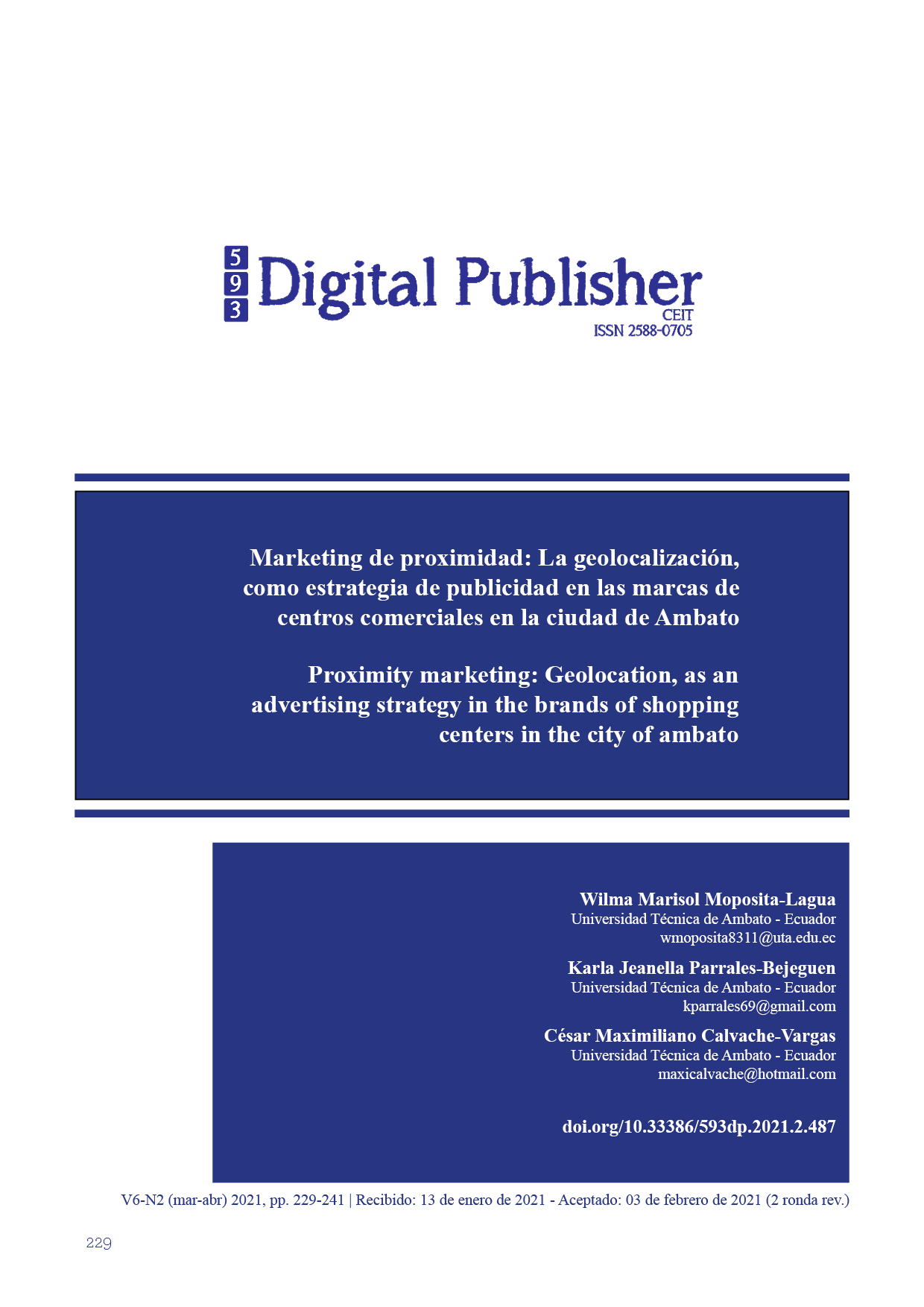Proximity marketing: Geolocation, as an advertising strategy in the brands of shopping centers in the city of ambato
Main Article Content
Abstract
Proximity marketing creates smart cities and geolocation as a digital advertising tool, eliminates traffic from retail purchases, delivers ads according to their locations, increases customer satisfaction by building customer loyalty, creates a positive brand image and a link between customer and supplier, facilitates the movement of revenue and marketing objectives within malls and shopping centers. The objective of the research was to identify the level of customer satisfaction with geolocation as an advertising strategy for shopping center brands in the city of Ambato. It had a secondary qualitative method, so a literature review of academic publications, articles published in scientific journals, statistical information, books and newspaper articles were carried out in order to carry out the study. Likewise, a quantitative approach was applied in the analysis of data collected in the application of the survey to carry out the study. The research had a correlational reach, since it was possible to calculate the level of satisfaction and the relation of the advertising of the brands of the shopping centers of the city of Ambato. The study sample was of three hundred and eighty-four (384) users, between 18 and 50 years old, data obtained from the Tungurahua 2019 - 2021 agenda. The main result obtained was the impact of the level of satisfaction and frequency of purchase in the shopping centers with the use of geolocalization: Facebook is the social network with the highest acceptance due to its versatility for receiving promotional notifications. It was concluded that geolocalized advertising strategies influence the purchase decision and contribute to the image and positioning of brands by creating strong links between the customer and the supplier.
Downloads
Article Details

This work is licensed under a Creative Commons Attribution-NonCommercial-ShareAlike 4.0 International License.
1. Derechos de autor
Las obras que se publican en 593 Digital Publisher CEIT están sujetas a los siguientes términos:
1.1. 593 Digital Publisher CEIT, conserva los derechos patrimoniales (copyright) de las obras publicadas, favorece y permite la reutilización de las mismas bajo la licencia Licencia Creative Commons 4.0 de Reconocimiento-NoComercial-CompartirIgual 4.0, por lo cual se pueden copiar, usar, difundir, transmitir y exponer públicamente, siempre que:
1.1.a. Se cite la autoría y fuente original de su publicación (revista, editorial, URL).
1.1.b. No se usen para fines comerciales u onerosos.
1.1.c. Se mencione la existencia y especificaciones de esta licencia de uso.
References
Albornoz, E., Núñez, F., y Mena, C. (2020). Geomarketing: Desde una visión comercial a una aplicación social, en contextos metropolitanos. Revista de Geografía Norte Grande, 76, 143-167. https://doi.org/10.4067/S0718-34022020000200143
AlBraheem, L., Al-Abdulkarim, A., Al-Dosari, A., Al-Abdulkarim, L., Al-Khudair, R., Al-Jasser, W., y Al-Angari, W. (2017). Smart city project using proximity marketing technology. 2017 Intelligent Systems Conference (IntelliSys), 177-183. https://doi.org/10.1109/IntelliSys.2017.8324288
Arenal, C. (2019). Políticas de marketing internacional. UF1782. Tutor Formación. https://books.google.com.ec/books?id=VtmsDwAAQBAJ&pg=PA1&dq=Arenal,+C.+(2019).+Pol%C3%ADticas+de+marketing+internacional.+UF1782.+San+Mill%C3%A1n:+Tutor+Formaci%C3%B3n.&hl=es-419&sa=X&ved=2ahUKEwiWvIfm_5buAhXBdN8KHWpUC-IQ6AEwAHoECAAQAg#v=onepage&q&f=false
Beltrán, G. (2015). La geolocalización social. Polígonos. Revista de Geografía, 0(27), 97-118. https://doi.org/10.18002/pol.v0i27.3290
Beltrán, G. (2016). Geolocalización online: La importancia del dónde. Editorial UOC.
Castaño, J., y Jurado, S. (2016). Marketing digital (Comercio electrónico). Editorial Editex. https://books.google.com.ec/books?id=5WZeDAAAQBAJ
Dávila, H., Palacios, I., Peña, H., y Valencia, J. (2019). Trade marketing como estrategia de posicionamiento empresarial. Revista de ciencias sociales, 25(Extra 1), 130-145.
Espinoza, G. (2019). Así es el uso de Internet en Ecuador. www.expreso.ec. https://www.expreso.ec/ciencia-y-tecnologia/internet-ecuador-479.html
Estrella, A., y Segovia, C. (2016). Comunicación integrada de marketing. ESIC Editorial. https://books.google.es/books?id=eoaCCwAAQBAJ
Gajanova, L., Kliestikova, J., y Nadanyiova, M. (2019). Application of NFC technology in proximity marketing. 167-170. https://doi.org/10.2991/iscde-19.2019.85
Galiana, P. (2018, marzo 28). Las principales redes sociales que usan las marcas para promocionarse [Informativa]. Thinking for Innovation. https://www.iebschool.com/blog/promocion-marcas-principales-redes-sociales/
Galindo, D., y Burgos, J. (2017). Geofencing, el poder de la geolocalización en la publicidad. http://repository.javeriana.edu.co/handle/10554/36109
Guaña, E., Quinatoa, E., y Pérez, M. (2017). Tendencias del uso de las tecnologías y conducta del consumidor tecnológico. Ciencias Holguín, 23(2), 15-30.
Heraldo. (2019, septiembre 29). Ambato, ciudad comercial. El Heraldo. https://www.elheraldo.com.ec/ambato-ciudad-comercial/
Hootsuite. (2020). Consumo de internet en Ecuador. Datta Business Innovation. https://datta.com.ec/articulo/datos-curiosos-sobre-el-consumo-de-los-servicios-digitales-en-ecuador
I. A. B., S. (2020, junio 18). Presentación Estudio Redes Sociales 2020. IAB Spain. https://iabspain.es/presentacion-estudio-redes-sociales-2020/
INEC. (2010). Fascículo Provincial Tungurahua (p. 8). https://www.ecuadorencifras.gob.ec/wp-content/descargas/Manu-lateral/Resultados-provinciales/tungurahua.pdf
INEC. (2016). Directorio de empresas y establecimientos 2016. https://www.ecuadorencifras.gob.ec/documentos/web-inec/Estadisticas_Economicas/DirectorioEmpresas/Directorio_Empresas_2016/Principales_Resultados_DIEE_2016.pdf
Internet World Stats. (2017). Ecuador Internet Usage Population and Telecom Reports [Estadísticca]. https://www.internetworldstats.com/sa/ec.htm
IRedes. (2016, marzo 15). iRedes 2016: “Mapa de las Redes Sociales y otros servicios en la Nube”. Red Comunicación. https://www.udla.edu.ec/comredudla/iredes-2016-mapa-de-las-redes-sociales-y-otros-servicios-en-la-nube/
Jácome, S. (2015). Detección y análisis de los segmento de mercado y los Factores más relevantes que inciden en la fidelización de Consumidores de un centro comercial de la ciudad de Quito para establecer estrategias de lealtad con el centro Comercial. https://repositorio.uide.edu.ec/handle/37000/975
Mejía, C., Bonilla, L., Ballesteros, L., y Guerrero, C. (2018). Estrategia de Geomarketing para la cadena de Farmacias Cruz Azul en la ciudad Ambato-Ecuador. Polo del Conocimiento: Revista científico - profesional, 3(12), 191-206. https://doi.org/10.23857/pc.v3i12.825
Mercadé, A. (2015). Geolocalización y redes sociales: Usos y ventajas. Deusto Formación. https://www.deustoformacion.com/blog/marketing-digital/geolocalizacion-redes-sociales-usos-ventajas
Morales, J. (2017). De la geolocalización al geotargeting: La evolución del marketing de proximidad. Thinking for Innovation. https://www.iebschool.com/blog/evolucion-geolocalizacion-geotargeting-proximidad-marketing-estrategico/
Muddinagiri, R., Ambavane, S., Jadhav, V., y Tamboli, S. (2020). Implementation of Proximity Marketing Leveraging Bluetooth Low Energy. 2020 International Conference on Electronics and Sustainable Communication Systems (ICESC), 608-612. https://doi.org/10.1109/ICESC48915.2020.9155756
Niño, J. (2015). Publicidad y Geolocalización (pp. 2-8). McGraw Hill Education.
Regueira, J. (2019). 25 marcas TOP de Interbrand: ¿cuáles utilizan estrategias PUSH y cuáles PULL? [Agencias]. Canal forMarketer. http://www.canalformarketer.com/agencias/25-marcas-top-de-interbrand-cuales-utilizan-estrategias-push-y-cuales-pull/
Rengifo, N., y Castillo, H. (2018). Marketing de proximidad para la fidelización de los clientes TIA Durán Recreo II, provincia Guayas. http://repositorio.ulvr.edu.ec/handle/44000/2478
Rodríguez, D., Miranda, J., Olmos, A., y Ordozgoiti, R. (2020). Publicidad online las claves del éxito en Internet. Madrid. https://books.google.es/books?id=fl3rDwAAQBAJ&printsec=frontcover&hl=es&source=gbs_ge_summary_r&cad=0#v=onepage&q&f=false
Rodríguez, E. (2017). La Geolocalización, Coordenadas hacia el Éxito. El potencial de la aplicación de una herramienta social de geolocalización en la comunicación institucional y corporativa. 1-12. https://www.researchgate.net/publication/317231998_La_Geolocalizacion_Coordenadas_hacia_el_Exito_El_potencial_de_la_aplicacion_de_una_herramienta_social_de_geolocalizacion_en_la_comunicacion_institucional_y_corporativa
Rykowski, J., Chojnacki, T., y Strykowski, S. (2018). In-Store Proximity Marketing by Means of IoT Devices. En L. M. Camarinha-Matos, H. Afsarmanesh, y Y. Rezgui (Eds.), Collaborative Networks of Cognitive Systems (pp. 164-174). Springer International Publishing. https://doi.org/10.1007/978-3-319-99127-6_15
Saldivar, H., y Zuñiga, J. (2019). Marketing de proximidad para centros comerciales con base a la tecnología de Beacons y dispositivos móviles. Universidad Tecnológica del Perú. http://repositorio.utp.edu.pe/handle/UTP/2175
Suárez, T. (2018). Evolución del marketing 1.0 al 4.0. Redmarka: revista académica de marketing aplicado, 22, 209-227. https://doi.org/10.17979/redma.2018.01.022.4943
Valdés, I. (2016, marzo 7). La actualidad del manifiesto SOLOMO (Social-Local-Móvil) [Sociología de las Redes Sociales. Marketing Digital]. SOCIÓLOGOHOLIC. http://sociologoholic.blogspot.com/2016/03/la-actualidad-del-manifiesto-solomo.html
Zamarreño, G. (2019). Marketing Estratégico. Editorial Elearning, S.L.




